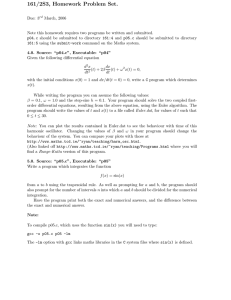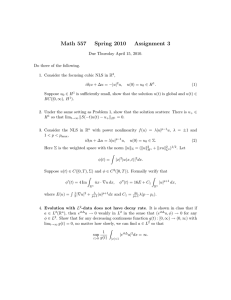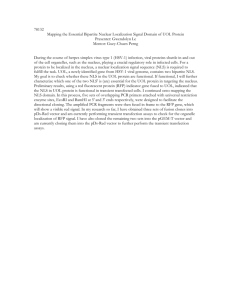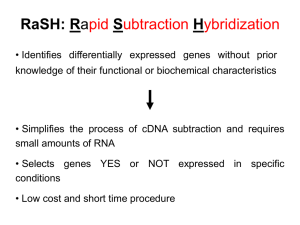A Fast Algorithm for Maximum Likelihood
advertisement
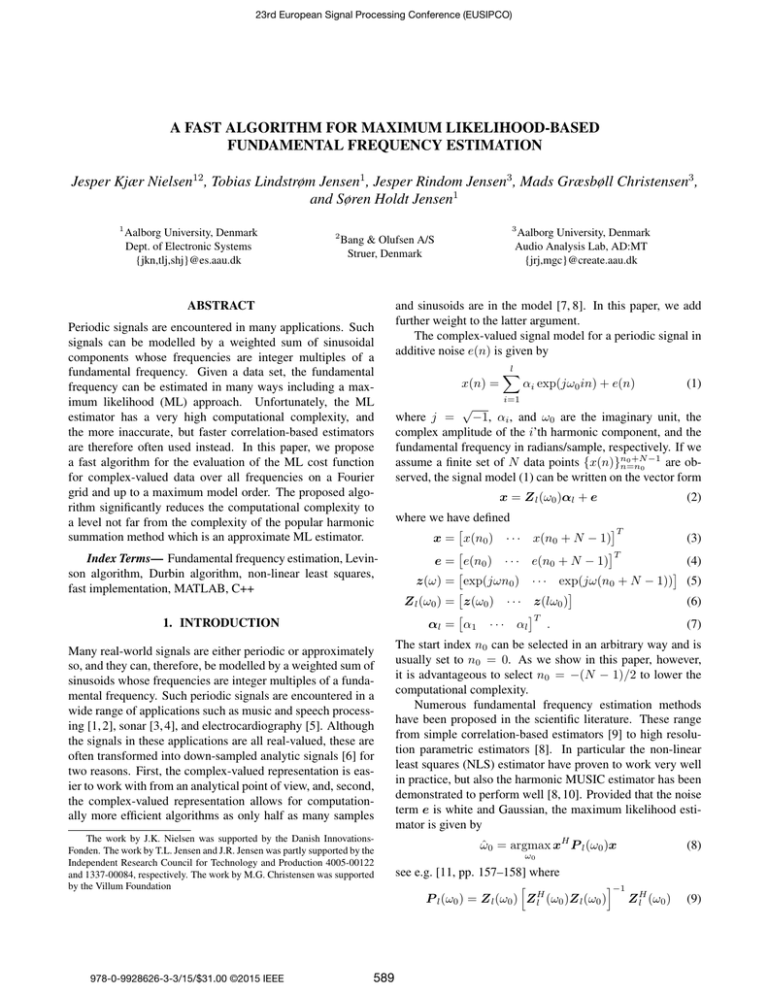
23rd European Signal Processing Conference (EUSIPCO)
A FAST ALGORITHM FOR MAXIMUM LIKELIHOOD-BASED
FUNDAMENTAL FREQUENCY ESTIMATION
Jesper Kjær Nielsen12 , Tobias Lindstrøm Jensen1 , Jesper Rindom Jensen3 , Mads Græsbøll Christensen3 ,
and Søren Holdt Jensen1
1
Aalborg University, Denmark
Dept. of Electronic Systems
{jkn,tlj,shj}@es.aau.dk
3
2
ABSTRACT
Periodic signals are encountered in many applications. Such
signals can be modelled by a weighted sum of sinusoidal
components whose frequencies are integer multiples of a
fundamental frequency. Given a data set, the fundamental
frequency can be estimated in many ways including a maximum likelihood (ML) approach. Unfortunately, the ML
estimator has a very high computational complexity, and
the more inaccurate, but faster correlation-based estimators
are therefore often used instead. In this paper, we propose
a fast algorithm for the evaluation of the ML cost function
for complex-valued data over all frequencies on a Fourier
grid and up to a maximum model order. The proposed algorithm significantly reduces the computational complexity to
a level not far from the complexity of the popular harmonic
summation method which is an approximate ML estimator.
Index Terms— Fundamental frequency estimation, Levinson algorithm, Durbin algorithm, non-linear least squares,
fast implementation, MATLAB, C++
1. INTRODUCTION
Many real-world signals are either periodic or approximately
so, and they can, therefore, be modelled by a weighted sum of
sinusoids whose frequencies are integer multiples of a fundamental frequency. Such periodic signals are encountered in a
wide range of applications such as music and speech processing [1, 2], sonar [3, 4], and electrocardiography [5]. Although
the signals in these applications are all real-valued, these are
often transformed into down-sampled analytic signals [6] for
two reasons. First, the complex-valued representation is easier to work with from an analytical point of view, and, second,
the complex-valued representation allows for computationally more efficient algorithms as only half as many samples
The work by J.K. Nielsen was supported by the Danish InnovationsFonden. The work by T.L. Jensen and J.R. Jensen was partly supported by the
Independent Research Council for Technology and Production 4005-00122
and 1337-00084, respectively. The work by M.G. Christensen was supported
by the Villum Foundation
978-0-9928626-3-3/15/$31.00 ©2015 IEEE
Aalborg University, Denmark
Audio Analysis Lab, AD:MT
{jrj,mgc}@create.aau.dk
Bang & Olufsen A/S
Struer, Denmark
589
and sinusoids are in the model [7, 8]. In this paper, we add
further weight to the latter argument.
The complex-valued signal model for a periodic signal in
additive noise e(n) is given by
x(n) =
l
X
αi exp(jω0 in) + e(n)
(1)
i=1
√
where j = −1, αi , and ω0 are the imaginary unit, the
complex amplitude of the i’th harmonic component, and the
fundamental frequency in radians/sample, respectively. If we
n0 +N −1
assume a finite set of N data points {x(n)}n=n
are ob0
served, the signal model (1) can be written on the vector form
x = Z l (ω0 )αl + e
where we have defined
T
x = x(n0 ) · · · x(n0 + N − 1)
T
e = e(n0 ) · · · e(n0 + N − 1)
z(ω) = exp(jωn0 ) · · · exp(jω(n0 + N − 1))
Z l (ω0 ) = z(ω0 ) · · · z(lω0 )
T
αl = α1 · · · αl
.
(2)
(3)
(4)
(5)
(6)
(7)
The start index n0 can be selected in an arbitrary way and is
usually set to n0 = 0. As we show in this paper, however,
it is advantageous to select n0 = −(N − 1)/2 to lower the
computational complexity.
Numerous fundamental frequency estimation methods
have been proposed in the scientific literature. These range
from simple correlation-based estimators [9] to high resolution parametric estimators [8]. In particular the non-linear
least squares (NLS) estimator have proven to work very well
in practice, but also the harmonic MUSIC estimator has been
demonstrated to perform well [8, 10]. Provided that the noise
term e is white and Gaussian, the maximum likelihood estimator is given by
ω̂0 = argmax xH P l (ω0 )x
(8)
ω0
see e.g. [11, pp. 157–158] where
h
i−1
P l (ω0 ) = Z l (ω0 ) Z H
ZH
l (ω0 )Z l (ω0 )
l (ω0 )
(9)
23rd European Signal Processing Conference (EUSIPCO)
is the projection matrix for the column space of Z l (ω0 ). If the
assumption on the noise is not fulfilled, then the estimator is
known as the NLS estimator. Since the maximum likelihood
estimator is a special case of the NLS estimator, we will use
the term NLS estimator in the rest of the paper. Similarly, the
harmonic MUSIC estimator is the solution to
ω̂0 = argmax
ω0
l
X
sH
i P l (ω0 )si
(10)
i=1
where {si }li=1 are l data-dependent vectors spanning the socalled signal subspace [12]. Other fundamental frequency
estimators, however, involve cost-functions on slightly different forms, such as the filtering methods in [13]. Consequently, the fast implementations herein does not apply directly to these, but similar ideas can be used to obtain fast implementations as explained in [14]. The major disadvantage
of the abovementioned estimators are that the cost functions
in the above optimisation problems have a very oscillatory
behaviour and can therefore only be maximised using a computationally complex search over a fine grid. Consequently,
faster, but less accurate methods such as the harmonic summation (HS) method [15] based on the asymptotic result that
limN →∞ N −1 Z H
l (ω0 )Z l (ω0 ) = I l are used instead. However, especially for low fundamental frequencies, these methods perform quite poorly [12]. Moreover, for joint fundamental frequency and model order estimation as, e.g., suggested
in [16], the value of the exact NLS cost function is required.
We note that fundamental frequency estimation is often used
in multi fundamental frequency estimation [8].
For fundamental frequency estimation, model order comparison is very important to, e.g., avoid the problem of pitch
halving and doubling. Nevertheless, the model order l is
often assumed to be known a priori, and we believe that the
computational complexity is a major reason for this. For a
given model l, the complexity for computing the NLS cost
function in (8) for a candidate fundamental frequency is
O(l2 N )+O(l3 ). Thus, if the NLS cost function is evaluated
naïvely over a grid of F/l candidate fundamental frequencies up to a model order of L, the order of complexity is
O(F log F )+O(F L3 ). To the best of our knowledge, no
NLS- or MUSIC-based methods have been published for
joint fundamental frequency and model order estimation
which has lower than this cubic complexity in L.
In this paper, we propose a fast algorithm for the evaluation of the exact cost function of the NLS method in (8)
over the Fourier grid for all candidate model orders up to
L. The proposed algorithm has only linear complexity in L
as it reduces the complexity from O(F log F )+O(F L3 ) to
just O(F log F )+O(F L) which is the same order as the HS
method. Moreover, the algorithm can also be vectorised so
that the cost function for a candidate model order is computed
for all candidate fundamental frequencies at once. This gives
a huge boost in speed for a MATLAB implementation. In
addition to a MATLAB implementation, we also provide an
590
Algorithm 1 The standard algorithm for computing the NLS
cost function for L model orders and F fundamental frequencies on the Fourier grid. The notation and [·]i,k denotes
element-wise multiplication and element (i, k), respectively.
1: f = fft(x)
. O(F log F )
∗
2: [J ]1,1:F = N −1 (f f )T
. O(F )
3: for l ∈ 2, 3, . . . , L do
4:
for f ∈ {1, 2, . . . , dF/le} do
5:
ω0 = 2π(f − 1)/F
. O(1)
6:
bl = S l f
. O(1)
7:
Solve Z H
(ω
)Z
(ω
)α
=
b
for
α
.
O(l3 )
0
l
0
l
l
l
l
H
8:
[J ]l,f = bl αl
. O(l)
even faster C++-implementation. The results can also be used
in the evaluation of the harmonic MUSIC cost function in (10)
which has a very similar structure to the NLS cost function.
The huge speed up is obtained by using the particular structure in the complex-valued projection matrix (9) which allow
us to use the Levinson algorithm in a clever way. Unfortunately, the same structure does not exist in the real-valued
case, but we believe that the results presented here is also a
first step in developing a fast algorithm for the real-valued
NLS estimator.
2. FAST EVALUATION OF THE NLS COST
FUNCTION
In this section, we derive the fast algorithm we advertised in
the introduction. We assume that we have to compute the cost
dF/le
function over a uniform grid Ωl = {2π(f − 1)/F }f =1 consisting of dF/le points for all model orders l ∈ {1, . . . , L}.
The upper limit depends on l since ω0 ∈ (0, 2π/l) to ensure
that lω0 ∈ (0, 2π). Before we present the fast algorithm,
however, we first briefly outline the standard algorithm for
computing this cost function.
2.1. The Standard Algorithm
The NLS cost function is typically evaluated as outlined in
algorithm 1. The cost in line 6 is set to one since bl is only a
subset of the elements in f described via the selection matrix
S l . Depending on the size of F and L, the major contributions are either the computations in line 1 or line 7. Since
L dF/le
X
X
O(l3 ) = O(F L3 ) ,
(11)
l=1 f =1
the time complexity of the standard implementation is therefore O(F log F )+O(F L3 ). The HS method is algorithm 1
with line 7 approximated as N I l αl = bl .
23rd European Signal Processing Conference (EUSIPCO)
2.2. A Fast Algorithm
We are now ready to present the fast algorithm. Before presenting the details of the algorithm, however, we first highlight the key facts that lead to the algorithm.
1. In order to compute the cost function efficiently, we
have to solve line 7 of algorithm 1
Al αl = bl
(12)
for αl in an efficient way where
Al =
bl =
µl = γl (bl − aTl−1 J l−1 αl−1 )
(18)
v l = αl−1 + µl J l−1 y l−1
T
αl = v Tl µl
(19)
(20)
where γl and y l−1 are computed in the Durbin algorithm.
Note that all operations require complex-valued algebra.
2.2.2. The Real-valued Durbin Algorithm
ZH
l (ω0 )Z l (ω0 )
H
Z l (ω0 )x .
(13)
(14)
2. The (i, k)’th element of the matrix Al is given by
[Al ]i,k = z H (iω0 )z(kω0 )
N
= exp(jω0 [i − k] n0 −
× sin(N [i−k]ω0 /2])
sin([i−k]ω0 /2])
of Al in reverse order. It is not hard to show that the solution
αl can be computed with a linear complexity as
(15)
for i = k
N −1
2
)
for i 6= k
(16)
3. As seen from (16), the matrix Al is a Hermitian and
Toeplitz matrix. Therefore, (12) can be solved efficiently using the Levinson algorithm [17]. We note in
passing that the Toeplitz structure does not exist in the
real-valued case (not even a block-Toeplitz structure).
4. The Levinson algorithm computes the solution to (12)
iteratively for all model orders. Thus, we can compute
the solution to (12) for all models orders by just running
the Levinson algorithm once.
5. As alluded to earlier, the value of the NLS cost function does not depend on how we select the time index
n0 . We therefore select it as n0 = −(N −1)/2 since the
matrix Al is then a real-valued matrix (see (16)). Thus,
the Durbin step inside the Levinson algorithm only involves real-valued algebra.
Although both the Levinson and the Durbin algorithms are
well-known, we briefly describe them here for the sake of
completeness. See a much more complete treatment in [17].
Suppose we have computed the solution to Al−1 y l−1 =
−al−1 . We now wish to solve Al y l = −al written as
Al−1
J l−1 al−1 z l
al−1
=
−
(21)
aTl−1 J l−1
N
βl
al
where al is the lower left element of Al+1 . As in the Levinson algorithm, the solution y l can be computed with a linear
complexity as
2
γl = (N + aTl−1 y l−1 )−1 = γl−1 (1 − βl−1
)−1
(22)
βl = −γl (al + aTl−1 J l−1 y l−1 )
(23)
z l = y l−1 + βl J l−1 y l−1
T
y l = z Tl βl
.
(24)
(25)
Note that the Durbin step does not depend on the data x. The
quantities y l and γl can therefore be computed offline for all
candidate model orders and fundamental frequencies and be
stored in a look-up table in memory. This is also much more
memory efficient than storing A−1
in memory for all candil
date model orders and fundamental frequencies.
2.2.3. The Algorithm
By using the Levinson algorithm to solve the problem in (12),
we therefore get a significant speed-up in computing the exact
NLS cost function for all model orders up to L and for all
frequencies on the Fourier grid. The algorithm is outlined in
algorithm 2, and its computational complexity can be shown
to be O(F log F )+O(F L). Moreover, we note the following
about the proposed algorithm.
2.2.1. The Levinson Algorithm
1. The outer for-loop over all the frequencies is used in
algorithm 2 to keep a simpler notation. In practice, everything inside the outer loop can be vectorised, and
this is done in our MATLAB implementation.
Suppose we have computed the solution to Al−1 αl−1 = bl−1
and wish to solve Al αl = bl which we write as
Al−1
J l−1 al−1 v l
bl−1
=
(17)
aTl−1 J l−1
N
µl
bl
2. In the algorithm, the fundamental frequency is running
in the range (0, 2π/l). However, in both our MATLAB
and C++-implementations, a lower and an upper bound
can be specified inside this interval, and the cost function is not calculated outside these bounds.
where J l−1 is the l − 1 × l − 1 exchange matrix and al−1 is
a vector containing the first l − 1 elements of the last column
3. In line 12 of the algorithm, a complex exponential pl
is multiplied onto the DFT element computed in line 1
to compensate for the start index n0 = −(N − 1)/2
compared to a standard FFT algorithm using n0 = 0.
591
23rd European Signal Processing Conference (EUSIPCO)
13:
14:
15:
16:
17:
18:
19:
20:
21:
22:
2
γl = γl−1 (1 − βl−1
)−1
. O(1)
T
µl = γl [bl ]l − al−1 J l−1 αl−1
. O(l)
v l = αl−1 + µl J l−1 y l−1
. O(l)
T
αl = v Tl µl
. O(1)
α
. O(l)
[J ]l,f = bH
l
l
if l < L then
al−1
al =
. O(1)
sin(N lω0 /2)/ sin(lω0 /2) βl = −γl [al ]l + aTl−1 J l−1 y l−1 . O(l)
z l = y l−1 + βl J l−1 y l−1
. O(l)
T
T
y l = z l βl
. O(1)
4. Line 1, 2, 9, 8, 12, 14, 15, and 17 involve complexvalued algebra. The remaining lines only involve realvalued algebra.
5. Although the algorithm is presented for a uniform grid
of frequencies, it can easily be modified to compute the
value of the NLS cost function for just a single and arbitrary frequency and model order. However, the computational saving are only in the order of L (instead of
L2 ) in this case since we cannot exploit that the solutions to all models orders up to a certain candidate order
are computed in the same recursion.
3. RESULTS
In this section, we evaluate the computational saving of our
proposed algorithm. Specifically, we compare the computation speed of computing the exact NLS cost function to the
HS method. As described earlier, the latter is a very fast, but
approximate way of computing the NLS cost function. As we
show via the example in Fig. 1, the approximation is good
unless the fundamental frequency is low.
592
NLS Cost [·]
1,500
Alg. 1
Alg. 2
HS
1,000
500
0
0
ω0
2
4
6
8
10
·10
f [cycles/sample]
−2
Fig. 1. An example of the exact (for both alg. 1 and 2) and
HS cost functions for N = 100 and L = 10.
Alg. 1
Alg. 2
Alg. 2 C++
HS
101
t [s]
Algorithm 2 A fast algorithm for computing the NLS cost
function for L model orders and F fundamental frequencies
on the Fourier grid. The notation and [·]i,k denotes elementwise multiplication and element (i, k), respectively.
1: f = fft(x)
. O(F log F )
∗
2: [J ]1,1:F = N −1 (f f )T
. O(F )
3: for f ∈ {2, 3, . . . , F } do
4:
ω0 = 2π(f − 1)/F
. O(1)
5:
a1 = sin(N ω0 /2)/ sin(ω0 /2)
. O(1)
6:
γ1 = N −1
. O(1)
7:
β1 = y 1 = −γ1 a1
. O(1)
. O(1)
8:
b1 = [f ]f exp(jω0 N 2−1 )
9:
α1 = γ1 b 1
. O(1)
10:
for l ∈ 2, 3, . . . , L do
11:
if f < dF/le
# 2π/l)
" then . Ensure that ω0 ∈ (0,
bl−1
. O(1)
12:
bl =
[f ]l(f −1)+1 exp jω0 l(N2−1)
10−1
10−3
10
20
30
40
50
L
Fig. 2. The computation time for four different ways of computing either the exact or the approximate NLS cost function
for N = 200 and F = 5N L.
The algorithms have been implemented in MATLAB
and line 2-25 of algorithm 2 have also been implemented in
C++ with a MATLAB interface using mex. Specifically, the
C++ implementation uses BLAS level 1 from the MATLAB
library lwblas and element-wise operations are implemented as simple for-loops. To compare the computation
speed of our implementations, we run a benchmark procedure. Timings are obtained by computing 10i solutions for
the smallest i ∈ {0, 1, 2, · · · } such that the execution time
t0 ≥ 0.2 s and then reporting the minimum (average) time
t = min(t1 , t2 , t3 )/10i over 3 repetitions (same as iPython’s
magic function timeit [18]). All timings are executed on
an Intel(R) Dual Core(TM) i5-2410M CPU at 2.3 GHz with
Ubuntu Linux kernel 3.13.0-24-generic and Matlab 8.4.0. All
these implementations and the code for generating the results
presented here are available from http://kom.aau.dk/
~jkn/publications/publications.php.
In Fig. 2, we have compared the computation speed for
N = 200 data points and a variable model order from L = 5
to L = 50. The number of grid points F is set to 5N L since
we have found that this resolution is sufficient not to miss
the true peak in the cost function. The figure clearly shows
that both the MATLAB and the C++-implementations of algorithm 2 are much faster than the implementation of algorithm 1. Moreover and more interestingly, the MATLAB and
the C++-implementations are only approximately 1.5 and 4
times slower, respectively, than the MATLAB implementa-
23rd European Signal Processing Conference (EUSIPCO)
Alg. 1
Alg. 2
Alg. 2 C++
[3] G. Ogden, L. Zurk, M. Siderius, E. Sorensen, J. Meyers,
S. Matzner, and M. Jones, “Frequency domain tracking of passive vessel harmonics,” J. Acoust. Soc. Am., vol. 126, no. 4, pp.
2249–2249, 2009.
HS
t [s]
102
100
[4] G. L. Ogden, L. M. Zurk, M. E. Jones, and M. E. Peterson, “Extraction of small boat harmonic signatures from passive sonar,”
J. Acoust. Soc. Am., vol. 129, no. 6, pp. 3768–3776, Jun. 2011.
10−2
200
400
600
800
1,000
N
Fig. 3. The computation time for four different ways of computing either the exact or the approximate NLS cost function
for L = 30 and F = 5N L.
tion of the HS method whereas the standard implementation is
approximately 450 times slower. The same trend is shown in
Fig. 3. Here, the model order is fixed to L = 30 and the number of data points is varied from N = 50 to 1000. Again, the
MATLAB and the C++-implementations of algorithm 2 are
much faster than the implementation of algorithm 1 and only
slightly slower than the implementation of the HS method.
Although not shown here, we have observed the same trend
when we fixed the ratio between N and L and varied N .
4. CONCLUSION
For the problem of joint fundamental frequency and model
order estimation as suggested in [16], the main computational
cost is the evaluation of the non-linear least squares (NLS)
cost function over a Fourier grid of candidate frequencies for
all model orders up to a maximum model order. In this paper, we have proposed a new and fast algorithm based on
the Levinson algorithm for evaluating this cost function from
complex-valued data. The proposed algorithm reduces the
computational complexity from O(F log F )+O(F L3 ) to just
O(F log F )+O(F L) where F is the number of points in the
Fourier grid and L is the maximum number of sinusoidal
components. Via simulations, we have shown that both a
MATLAB and a C++-implementation of the proposed algorithm reduces the computation time to a level not far from
the complexity of the popular harmonic summation method
which is an approximate NLS estimator. Moreover, the reduction in computation time also makes the exact NLS estimator
much more attractive in comparison to the inaccurate, but fast
and popular correlation-based methods.
5. REFERENCES
[1] N. H. Fletcher and T. D. Rossing, The Physics of Musical Instruments, 2nd ed. Springer, Jun. 1998.
[2] R. J. Sluijter, “The development of speech coding and the first
standard coder for public mobile telephony,” Ph.D. dissertation, Techniche Universiteit Eindhoven, 2005.
593
[5] V. K. Murthy, L. J. Haywood, J. Richardson, R. Kalaba,
S. Salzberg, G. Harvey, and D. Vereeke, “Analysis of power
spectral densities of electrocardiograms,” Mathematical Biosciences, vol. 12, no. 1–2, pp. 41–51, Oct. 1971.
[6] S. L. Marple, Jr., “Computing the discrete-time "analytic" signal via FFT,” IEEE Trans. Signal Process., vol. 47, no. 9, pp.
2600–2603, Sep. 1999.
[7] M. G. Christensen, A. Jakobsson, and S. H. Jensen, “Joint
high-resolution fundamental frequency and order estimation,”
IEEE Trans. Audio, Speech, Lang. Process., vol. 15, no. 5, pp.
1635–1644, Jul. 2007.
[8] M. G. Christensen and A. Jakobsson, Multi-Pitch Estimation,
B. H. Juang, Ed. San Rafael, CA, USA: Morgan & Claypool,
2009.
[9] L. R. Rabiner, “On the use of autocorrelation analysis for
pitch detection,” IEEE Trans. Acoust., Speech, Signal Process.,
vol. 25, no. 1, pp. 24–33, Feb. 1977.
[10] J. Tabrikian, S. Dubnov, and Y. Dickalov, “Maximum aposteriori probability pitch tracking in noisy environments using harmonic model,” IEEE Trans. Speech Audio Process.,
vol. 12, no. 1, pp. 76–87, 2004.
[11] P. Stoica and R. L. Moses, Spectral Analysis of Signals.
glewood Cliffs, NJ, USA: Prentice Hall, May 2005.
En-
[12] M. G. Christensen, “Accurate estimation of low fundamental
frequencies from real-valued measurements,” IEEE Trans. Audio, Speech, Lang. Process., vol. 21, no. 10, pp. 2042–2056,
2013.
[13] M. G. Christensen, J. H. Jensen, A. Jakobsson, and S. H.
Jensen, “On optimal filter designs for fundamental frequency
estimation,” IEEE Signal Process. Lett., vol. 15, pp. 745–748,
2008.
[14] J. R. Jensen, G.-O. Glentis, M. G. Christensen, A. Jakobsson,
and S. H. Jensen, “Fast LCMV-based methods for fundamental
frequency estimation,” IEEE Trans. Signal Process., vol. 61,
no. 12, pp. 3159–3172, Jun. 2013.
[15] A. M. Noll, “Pitch determination of human speech by the harmonic product spectrum, the harmonic sum spectrum, and a
maximum likelihood estimate,” in Proc. of the symposium on
computer process. commun., vol. 779, 1969.
[16] J. K. Nielsen, M. G. Christensen, and S. H. Jensen, “Default Bayesian estimation of the fundamental frequency,” IEEE
Trans. Audio, Speech, Lang. Process., vol. 21, no. 3, pp. 598–
610, Mar. 2013.
[17] G. H. Golub and C. F. van Loan, Matrix Computations, 3rd ed.
The Johns Hopkins University Press, Oct. 1996.
[18] IPython Documentation, The IPython Development Team,
2014, v. 1.2.1, http://ipython.org/ipython-doc/1/index.html.
